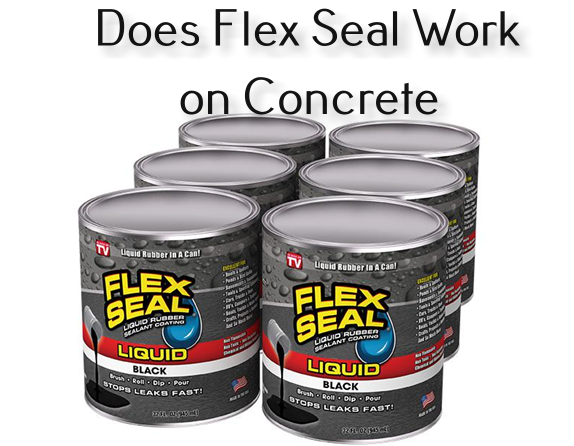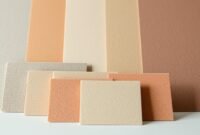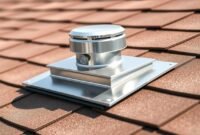Are you tired of dealing with cracked, leaky concrete? It can be really frustrating. Water can get in, weaken the structure, and cost a lot to fix. Traditional sealants often don’t work, leaving you looking for something better.
Flex Seal is a game-changer for concrete repair. It’s a flexible, waterproof seal that covers well and stands up to heat. It’s great for fixing small cracks or big damage, thanks to its liquid rubber technology.

This sealant can really change your repair projects. It creates a strong barrier against moisture and weather. Let’s explore how Flex Seal works on concrete and why it might be what you need.
Understanding Flex Seal and Its Properties
As someone who loves fixing concrete, I found Flex Seal to be a real game-changer. It’s a top-notch sealant that stands out from the rest. Its unique properties make it perfect for protecting and fixing different surfaces.
Flex Seal is known for its amazing performance. It uses a special liquid formula to create a strong waterproof barrier. It’s considered the best concrete sealant, thanks to its impressive properties.
What Makes Flex Seal Unique
- Penetrates deep into surface cracks
- Creates a rubberized protective layer
- Works across multiple material types
- Provides exceptional water resistance
Key Components of Flex Seal
| Property | Performance |
|---|---|
| Temperature Resistance | -20°F to 140°F |
| Application Range | 0°F to 100°F |
| Drying Time | Approximately 24 hours |
Versatility Across Materials
Flex Seal is incredibly versatile. It seals surfaces like concrete, masonry, glass, fabric, and plastics. Its thick spray formula goes deep and lasts long, making it perfect for many repair jobs.
Does Flex Seal Work on Concrete
As a DIY enthusiast, I’ve found Flex Seal to be a top choice for sealing concrete. It’s a liquid rubber sealant that works well on many concrete surfaces. It’s great for sealing cracks in basements, driveways, and outdoor areas.
Flex Seal stands out for several reasons:
- Mildew and chemical resistant properties
- UV protection for long-lasting performance
- Versatile application methods
- Weather-resistant coating
Applying Flex Seal is easy. You can brush, roll, or pour it into cracks. It’s perfect for keeping basements dry and preventing water damage.
| Concrete Surface | Flex Seal Performance |
|---|---|
| Driveways | Excellent crack sealing |
| Cinderblock walls | Strong weatherization |
| Basement walls | Superior waterproofing |
For the best results, apply Flex Seal carefully. Wait 24 hours between coats and 48 hours for it to fully cure. It’s great at stopping erosion and protecting concrete from the elements.
Benefits of Using Flex Seal on Concrete Surfaces
Flex Seal is a top choice for fixing concrete problems. It’s easy to use and works well. DIY fans and homeowners love it for its many benefits.
Weather Resistance Properties
Flex Seal is great at keeping concrete dry. It stops water from getting in and protects against UV rays. It also keeps rust and corrosion away.
- Blocks water penetration effectively
- Provides UV protection for concrete surfaces
- Prevents rust and corrosion
Read also: How an Anode Rod Protects Water Heater ?
Durability and Longevity
Flex Seal is very durable. It can handle tough weather and lasts a long time. It’s perfect for fixing many types of concrete problems.
| Property | Performance Metric |
|---|---|
| Drying Time | 24-48 hours |
| Crack Size Suitability | Small to medium cracks |
| UV Resistance | Excellent protection |
Cost-Effectiveness
Flex Seal is also a smart choice for saving money. It fixes small cracks and stops bigger problems from happening. This saves you from expensive repairs later on.
- Reduces long-term maintenance costs
- Easy DIY application
- Prevents expensive structural repairs
In short, Flex Seal is a smart, affordable way to keep concrete in good shape. It’s easy to use and saves you money in the long run.
Preparing Concrete Surfaces for Flex Seal Application
Before you apply Flex Seal, you need to prepare the surface. I’ll show you how to get your surface ready for the best results.
Cleaning the surface is the first step. Remove all dirt, dust, and loose debris. A clean surface helps Flex Seal stick better and seal more effectively.
- Remove loose particles with a stiff brush
- Use a damp rag with mild cleaning solution for stubborn dirt
- Sand off any rust or rough patches
- Ensure the surface is completely dry before application
When applying Flex Seal, the surface condition is key. Dry surfaces work best, but it can also work on slightly damp areas. Make sure to prepare cinderblocks, driveways, and basement walls carefully.
| Surface Type | Preparation Method | Notes |
|---|---|---|
| Smooth Concrete | Light sanding | Improves adhesion |
| Rough Concrete | Thorough cleaning | Remove all loose particles |
| Rusty Surfaces | Sandblasting | Minimum 70 CFM @ 90 P.S.I. |
Pro tip: Dry the surface with a blower before applying Flex Seal. This step helps your concrete repair work better.
Step-by-Step Guide to Applying Flex Seal on Concrete
Sealing concrete surfaces needs care and the right steps. I’ll show you how to apply flex seal on concrete well. This way, you’ll get great results for your project.
Required Tools and Materials
Before sealing concrete cracks, get these key items:
- Flex Seal Liquid MAX
- Protective gloves
- Safety goggles
- Paintbrush or roller
- Clean rags
- Mineral spirits
Application Techniques
Follow these steps when applying flex seal to concrete:
- Clean the concrete surface well
- Make sure the area is dry
- Shake Flex Seal Liquid MAX for one minute
- Apply with a steady, sweeping motion
- Keep 8-12 inches distance while spraying
Drying Time and Curing Process
Patience is key during drying and curing:
| Stage | Duration | Recommendations |
|---|---|---|
| First Coat Drying | 24 hours | Ensure proper ventilation |
| Second Coat Application | After first coat dries | Use light, even strokes |
| Full Curing | 48 hours | Avoid heavy traffic on surface |
Pro tip: For the best protection, apply two coats of Flex Seal Liquid MAX. Let each coat dry fully. This method gives a strong, moisture-resistant seal that keeps your concrete safe from damage.
Preventing Mold and Moisture Problems

To keep your concrete safe from moisture and mold, you need a solid plan. A flexible waterproof seal is a great start to stop water damage and keep your structure strong.
Stopping moisture problems involves a few important steps:
- Find where water might get in
- Clean the surface well before you start
- Use a good seal work plan
- Check on the treated areas often
Flex Seal Liquid is a top choice for fixing concrete damage. It doesn’t get rid of mold, but it stops new growth by creating a strong barrier.
Here are some key ways to stop moisture:
- Clean the concrete well
- Get rid of any mold or mildew
- Put on Flex Seal Liquid evenly
- Let it dry fully between coats
Waterproofing basements needs extra care. I suggest using different Flex Seal products for the best protection.
| Moisture Prevention Method | Effectiveness |
|---|---|
| Flex Seal Liquid Application | High |
| Surface Preparation | Critical |
| Regular Inspection | Essential |
By following these steps, you can greatly lower the chance of moisture damage. This helps keep your concrete in top shape.
Common Concrete Problems Flex Seal Can Fix
Flex Seal is a versatile solution for fixing concrete problems. It can seal cracks and protect different concrete structures. I’ve seen it work well on many surfaces.
Flex Seal is great for solving several common concrete issues:
- Basement waterproofing challenges
- Driveway crack repairs
- Cinderblock surface sealing
- Erosion prevention in backyard concrete areas
It’s perfect for small repairs and keeping surfaces in good shape. I often suggest Flex Seal for:
- Sealing small holes and minor cracks
- Preventing water infiltration
- Protecting outdoor concrete from weather damage
- Temporary repairs on foundations and exterior surfaces
But, Flex Seal has its limits. It’s best for areas with little foot traffic and small repairs. For big damage or structural problems, you might need a pro.
Homeowners looking to fix cracks will find Flex Seal handy. Its liquid rubber formula creates a strong, waterproof seal. This helps protect concrete from further damage.
Read also: How to Fix Cracked Door Frame
When Not to Use Flex Seal on Concrete
Flex Seal is great for many surfaces, but not all. Knowing when not to use it on concrete is key. This helps protect your surfaces and get the best results.
Surface Conditions to Avoid
Before you apply Flex Seal to concrete, check these conditions:
- Extremely smooth or glossy concrete surfaces
- Areas with constant water submersion
- Surfaces experiencing high mechanical stress
- Concrete with significant structural damage
Alternative Solutions for Problematic Surfaces
For surfaces where Flex Seal isn’t the best choice, try these:
| Surface Condition | Recommended Alternative |
|---|---|
| High-traffic areas | Epoxy-based concrete sealers |
| Structural cracks | Professional concrete repair compounds |
| Underwater environments | Specialized marine-grade sealants |
Always test a small area before applying Flex Seal. This ensures it works well on your concrete without issues.
Flex Seal is versatile, but it’s not for every concrete problem. Check your needs and surface conditions to find the best sealant.
Maintenance Tips for Flex Seal Treated Concrete
Keeping your concrete surfaces in good shape after using Flex Seal is important. I’ll give you some useful tips to make your Flex Seal last longer and keep your concrete safe.
Regular care is key to keeping your concrete protected for a long time. Here are some important steps to keep your concrete looking great:
- Check sealed areas every 3-6 months for wear or damage
- Clean surfaces gently with soft brushes or low-pressure water
- Stay away from harsh chemical cleaners that can harm the seal
- Look for any cracks or signs of wear
Remember, Flex Seal is great at fighting off the weather. I suggest reapplying it every 2-3 years, depending on how much it’s exposed and how much traffic it gets.
Important maintenance steps include:
- Remove dirt and debris before checking
- Find weak spots in the seal
- Fix small damages right away
- Make sure water can drain away from sealed areas
Temperature and weather can affect how well your seal works. In very hot or cold places, you might need to check and reapply more often.
Pro tip: Always work in a well-ventilated area. Wait 24 hours between coats for best results. It takes about 48 hours for the seal to fully cure, giving you strong protection against moisture and damage.
Professional Tips for Best Results
Applying the best concrete sealant requires some key techniques to get the most out of Flex Seal. It’s all about preparation and strategy.

Experts say to follow these steps when sealing concrete with Flex Seal:
- Choose a temperature between 60°F to 150°F for the best results
- Make sure the surface is clean and dry before you start
- Apply thin coats, not one thick layer
- Wait 24-48 hours between each coat
- Keep the area well-ventilated while you work
Professional contractors have special tips for using Flex Seal on concrete. It’s all about knowing the product’s limits and getting the surface ready right.
| Application Technique | Recommended Practice |
|---|---|
| Temperature Range | 0°F to 150°F during application |
| Curing Time | 24-48 hours full cure |
| Coating Strategy | Multiple thin layers |
| Surface Preparation | Clean, dry, debris-free surface |
If you’re dealing with big concrete problems or complex sealing jobs, get help from pros. They know how to fix your concrete and make sure Flex Seal works its best.
Conclusion
Exploring concrete repair solutions, I found Flex Seal to be unique. It offers DIY-friendly options for minor repairs and leaks. This sealant is great for those who want to fix small issues on their own.
My research shows Flex Seal works well on concrete if used right. It’s not a magic solution, but it can be a big help for many homeowners. The trick is knowing its limits and preparing the surface well before applying it.
While Flex Seal is good for small problems, it’s not a fix for big structural issues. For serious problems, it’s best to get a professional. Think of Flex Seal as a temporary fix that can protect your concrete until you can get a more lasting solution.
Success with Flex Seal depends on good preparation, careful use, and knowing what to expect. It’s useful for sealing cracks, stopping moisture, and fixing minor issues. It’s a valuable tool for keeping your home in good shape.


